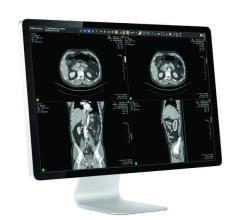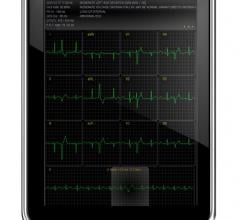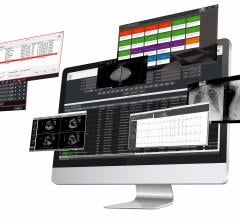
Sophisticated report templates with auto-population of data, such as the Infinitt Cardiology PACS Vascular Imaging with Cerebrovascular Carotid Report, have reduced errors and vastly improved data management at Warren Hospital.
Warren Hospital, an acute care community hospital serving Warren and Hunterdon counties in rural New Jersey, supports 214 patient beds and 140,000 outpatient visits per year. It was one of the first community hospitals in the United States to go filmless in radiology, having implemented its first PACS (picture archiving and communications system) prior to 2000, and drastically restricting access to the film printer right from day one.
The cardiology and cardiovascular departments, however, remained heavily dependent on paper and film. Offering a full array of diagnostic tests for evaluating heart conditions, including electrocardiograms (ECGs), echocardiography, cardiac catheterization, noninvasive vascular imaging and nuclear cardiology, cardiac imaging at Warren harbored workflow inefficiencies and bottlenecks that delayed report turnaround and left too much room for human error.
The Challenge
In 2007, Warren Hospital upgraded its radiology PACS to a third-generation Web-based system. The upgrade had a significant impact on the hospital, further reducing radiology report turnaround time, broadening access to images for radiologists and clinicians and improving patient care.
Two years later, with cardiac imaging volumes increasing and advancements in cardiac PACS technology, the demand for cardiology to move to a PACS environment became more pressing. Angela Collins, then manager of vascular services, championed the cause, as she knew their workflow was outdated and increased the chances for error.
It soon became apparent, however, that cardiology workflow was quite different from radiology. In cardiology there are a lot more data elements that need to be integrated. But, in a sense, this also meant cardiology had more to gain.
Warren was still managing and viewing image data from the cath lab, ECG, echocardiography and vascular imaging on videocassettes. It treated the cath, echo and vascular labs as separate entities and stored the various types of data output in different locations. In addition, tech notes, worksheets, reports, requisitions, tracings, statistics and emergency department notes were filed on paper.
“With different workflows, different modalities and different kinds of outputs, the cardiology environment is much more complex than radiology,” said Collins, who is now administrative director of radiology and cardiovascular services. “We knew that consolidating patient data in one place would make it easier for both radiologists and cardiologists to get a comprehensive view of a patient’s cardiovascular condition.”
From an administrative perspective, she said, cardiac imaging also has more stringent monthly reporting and accreditation requirements. In order to pool data for management reports — anything from staff productivity to resource utilization or monthly procedure volumes — she had to collect the data manually, which required an enormous amount of time.
“We wanted a comprehensive cardiology solution that would consolidate images from the cath lab, the echo lab and the vascular lab, store them in digital (DICOM) format, and provide all the workflow and reporting tools we needed to go filmless. What Infinitt has provided goes beyond image management,” Collins said.
The Solution
Despite initial resistance from cardiologists, Warren Hospital’s administration, with support from its information technology (IT) department, decided to go with the Infinitt Cardiology PACS solution. The system went live in the summer of 2009. Collins said the benefits have been even greater than they hoped for and the cardiologists are now some of the system’s strongest advocates.
Clinicians can now view a patient’s radiology and cardiology images from the same viewer with a single sign-on. They can compare vascular studies with computed tomography (CT) angiography, or pull up multiple modalities in the PACS viewer. Referring physicians can access images and reports from their offices or any Internet-connected or wireless personal computer (PC).
In addition, huge gains have been derived from the reporting system. Upon completion of cardiac exams, the system prepares the report automatically, eliminating the need for technologists to copy results to the report manually. The physician can see that the exams are there, read the study, approve the report with electronic signature and have it sent to the referring physician. These time-saving features have been critical to physician buy-in.
Also, simply by clicking on the patient’s name in the worklist, the technologist can see all prior exams and assess them to locate regions of particular interest. Efficiencies like these reduce exam and patient wait times and boost throughput to help generate additional revenue. Report turnaround time, which had been as long as three to four weeks for vascular studies, is now less than 24 hours.
Benefits
The system has also resulted in significant cost reductions, eliminating the cost of videotape, reducing off-site storage costs and saving $30,000 annually by eliminating transcription. Electronic signature has helped streamline workflow, and sophisticated report templates with auto-population of data have reduced errors and vastly improved data management.
Collins said her reporting burden has been alleviated greatly. “We now have monthly statistical reports tracking exam volume, number of exams per technologist and other things we used to count manually,” she said. “The Infinitt Cardiology PACS has cut the time it takes for accreditation/re-accreditation drastically. I‘m able to pull together the data I need for ICAVL (Intersocietal Commission for the Accreditation of Vascular Laboratories) accreditation more quickly, and I’m now planning to apply for first-time echo lab accreditation through ICAEL (Intersocietal Commission for the Accreditation of Echocardiography Laboratories).”
Collins said the cardiology PACS has helped to cut costs and improve productivity. Even more importantly, increased access to a comprehensive clinical record is helping diagnosticians and clinicians make better and timelier treatment decisions. Collins said this helps improve outcomes and reduces the length of patient stays.
This case study was supplied by Infinitt.



 March 06, 2024
March 06, 2024 



